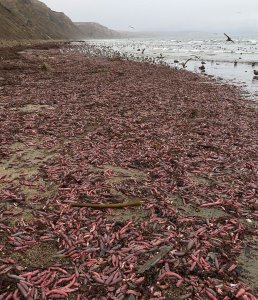Beachgoers may have found themselves in quite a pickle last week trying to identify thousands of gelatinous sea creatures that washed ashore during a strong storm in Northern California.

Molly Knight, a sportswriter for the Athletic, stumbled on the pebbled-surfaced creatures on the sand at Carmel Beach on Thursday, snapped a photo and asked Twitter to help her figure out what they were. The Monterey Bay Aquarium responded, explaining that big waves and strong currents pushed pyrosomes — formally known as Pyrosoma and colloquially called sea pickles — onto the beach.
“Though similar in appearance to ‘penis fish’ fat innkeeper worms when washed up, pyrosomes are in fact planktonic colonies of filter feeders some call sea pickles,” the aquarium wrote on Twitter. “Always something fun on the beach!”
The next day aquarium employees visited Asilomar State Beach in Pacific Grove, where thousands of the tubular tunicates had also washed up, and explained a little more about them in a video.
Read the full story on LATimes.com.












